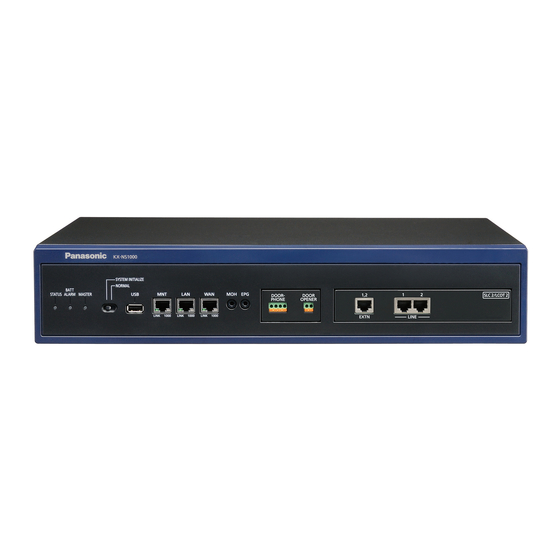
Panasonic KX-NS1000 Features Manual
Ip-pbx
Hide thumbs
Also See for KX-NS1000:
- Pc programming manual (1294 pages) ,
- Programming manual (1182 pages) ,
- Manual (542 pages)
Summary of Contents for Panasonic KX-NS1000
- Page 1 Feature Guide Pure IP-PBX KX-NS1000 Model No. Thank you for purchasing this Panasonic product. Please read this manual carefully before using this product and save this manual for future use. KX-NS1000: PCMPR Software File Version 001.00000 or later...
- Page 2 About this Feature Guide This Feature Guide is designed to serve as an overall feature reference for the Panasonic Pure IP-PBX. It explains what this PBX can do, and how to obtain the most out of its many features and facilities.
- Page 3 KX-NS1000UK and the KX-NS1000NE are in compliance with the essential requirements and other relevant provisions of Radio & Telecommunications Terminal Equipment (R&TTE) Directive 1999/5/EC. Declarations of Conformity for the relevant Panasonic products described in this manual are available for download by visiting: http://www.doc.panasonic.de...
- Page 4 List of Abbreviations List of Abbreviations CONR Connected Name Identification Restriction Automated Attendant Class of Service Automatic Call Distribution Calling Party Control Advice of Charge Cell Station Automatic Route Selection Call Transfer—by ISDN Computer Telephony Integration Background Music Basic Rate Interface Direct Dialling In DHCP Dynamic Host Configuration Protocol...
- Page 5 List of Abbreviations G-CO Group-CO Peer-to-Peer Primary Directory Number Incoming Call Distribution Personal Identification Number ICMP PING Internet Control Message Protocol Packet Internet Groper IP-PT P-MP IP Proprietary Telephone Point-to-multipoint IRNA Intercept Routing—No Answer Point-to-Point ISDN Integrated Services Digital Network Primary Rate Interface Portable Station L-CO...
- Page 6 List of Abbreviations Uniform Call Distribution Unified Messaging Uninterruptible Power Supply Voice Mail VoIP Voice over Internet Protocol Virtual Private Network EXtra Device Port Feature Guide...
- Page 7 Table of Contents Table of Contents 1 For Your Safety ..................15 For Your Safety .......................16 1.1.1 For Your Safety ......................16 2 Call Handling Features ................19 Incoming Call Features ....................20 2.1.1 Incoming Trunk Call Features ..................20 2.1.1.1 Incoming Trunk Call Features—SUMMARY ...............20 2.1.1.2 Direct In Line (DIL) ......................23 2.1.1.3...
- Page 8 Table of Contents 2.5.4.6 Trunk Busy Out ......................93 2.5.4.7 Pause Insertion ......................94 2.5.4.8 Host PBX Access Code (Access Code to the Telephone Company from a Host PBX) ..........................95 2.5.4.9 Special Carrier Access Code ..................97 2.5.5 Seizing a Line Features ....................98 2.5.5.1 Seizing a Line Features—SUMMARY .................98 2.5.5.2...
- Page 9 Table of Contents 2.14.1 Conference Features—SUMMARY ................166 2.14.2 Conference ........................167 2.14.3 Privacy Release ......................169 2.15 Conference Group Call Features .................170 2.15.1 Conference Group Call ....................170 2.16 Direct Inward System Access (DISA) Features ............173 2.16.1 Direct Inward System Access (DISA) ................173 2.16.2 Automatic Fax Transfer ....................183 2.17...
- Page 10 Table of Contents 2.28.2 Outgoing Message (OGM) ...................254 3 Unified Messaging System ..............257 Unified Messaging System Administration ..............258 3.1.1 Unified Messaging System Overview ................258 3.1.2 System Administration ....................260 3.1.2.1 Custom Service Builder .....................260 3.1.2.2 Default Mailbox Template ..................260 3.1.2.3 Password Administration ...................260 3.1.2.4 System Backup/Restore ....................261 3.1.2.5...
- Page 11 Table of Contents 3.2.1.41 Simplified Tutorial ......................284 3.2.1.42 System Prompts ......................285 3.2.1.43 Transfer Recall to a Mailbox ..................285 3.2.1.44 Transfer to Mailbox ....................286 3.2.1.45 Trunk Service (Universal Port) ..................286 3.2.1.46 Voice Mail Service .....................286 3.2.2 Subscriber Features .....................288 3.2.2.1 Auto Receipt ......................288 3.2.2.2 Automatic Fax Delivery ....................288 3.2.2.3...
- Page 12 Table of Contents 4.1.2.4 Call Forwarding (CF)—by ISDN (P-MP) ..............322 4.1.2.5 Call Forwarding (CF)—by ISDN (P-P) ...............324 4.1.2.6 Call Hold (HOLD)—by ISDN ..................326 4.1.2.7 Call Transfer (CT)—by ISDN ..................327 4.1.2.8 Three-party Conference (3PTY)—by ISDN ...............328 4.1.2.9 Malicious Call Identification (MCID) ................329 4.1.2.10 Completion of Calls to Busy Subscriber (CCBS) ............330 4.1.2.11...
- Page 13 Table of Contents 5.2.2.6 Virtual PS ........................438 5.2.3 ISDN Extension Features .....................440 5.2.3.1 ISDN Extension ......................440 E-mail Notification Features ..................442 5.3.1 E-mail Notification for Extension Users ................442 5.3.2 E-mail Notification of System-level Events ..............443 System Data Control .....................444 5.4.1 User Profiles .........................444 5.4.2 PC Programming ......................445 5.4.3...
- Page 14 Table of Contents Feature Guide...
- Page 15 Section 1 For Your Safety Feature Guide...
- Page 16 1.1.1 For Your Safety 1.1 For Your Safety 1.1.1 For Your Safety Description To prevent personal injury and/or damage to property, be sure to observe the following safety precautions. The following symbols classify and describe the level of hazard and injury caused when this unit is operated or handled improperly.
- Page 17 1.1.1 For Your Safety CAUTION • The software contained in the TRS/Barring and ARS features to allow user access to the network must be upgraded to recognise newly established network area codes and exchange codes as they are placed into service.
- Page 18 1.1.1 For Your Safety Feature Guide...
- Page 19 Section 2 Call Handling Features Feature Guide...
- Page 20 2.1.1 Incoming Trunk Call Features 2.1 Incoming Call Features 2.1.1 Incoming Trunk Call Features 2.1.1.1 Incoming Trunk Call Features—SUMMARY Description Incoming calls via a trunk (public line) are distributed to their destinations according to one of several distribution methods. Available Networking Type for Each Card Type Each trunk port of an optional trunk card or the mother board can be assigned a networking type: Public, Private, or VPN (Virtual Private Network).
















Need help?
Do you have a question about the KX-NS1000 and is the answer not in the manual?
Questions and answers